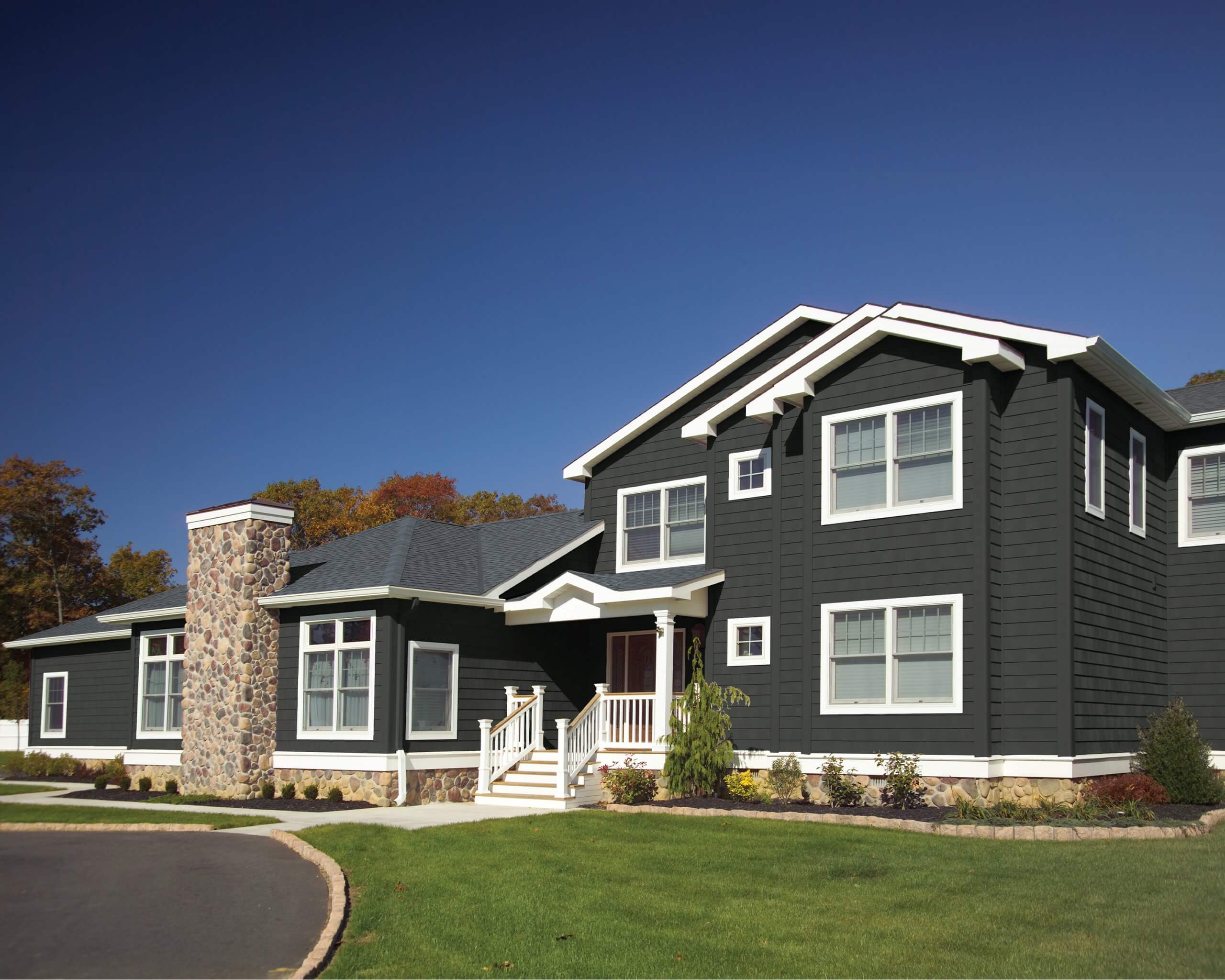Today, with nearly countless options, there is no shortage of considerations for selecting the right siding. Aesthetically, homeowners — and contractors and builders set on meeting their demands — have a lot more options than simply putting up aluminum or vinyl lap siding panels, which were popular for decades.
Meanwhile, elements of water resistance, energy efficiency, and durability continue to be important considerations. Finally, with time meaning money for everyone involved, ease of installation is a key consideration.
Warmer tones
Long gone are the stark white profile sidings of the past. In recent years, dark colours and tones have been popular across the home, accenting trim, windows, doors, and siding with black or near-black colours.
“The last couple of years, black, dark browns, and dark greys were the main requested colours,” says Maurizio Scatozza, Regional Manager at Royal Building Solutions.

Photo courtesy of Royal Building Solutions
“That’s still trending. We do stock more on black colours and dark greys like ‘gunmetal’ or what we call ‘iron stone’… I’ve noticed a bit of a trend starting towards more of the warmer colours.”
“Browns are starting to be requested again, and interestingly enough, some creams as well.”
He says he’s also seeing a greater interest in wood grain textures, and related colours, although not necessarily wood — with homeowners favouring the easier maintenance of vinyl, aluminum, or steel sidings.
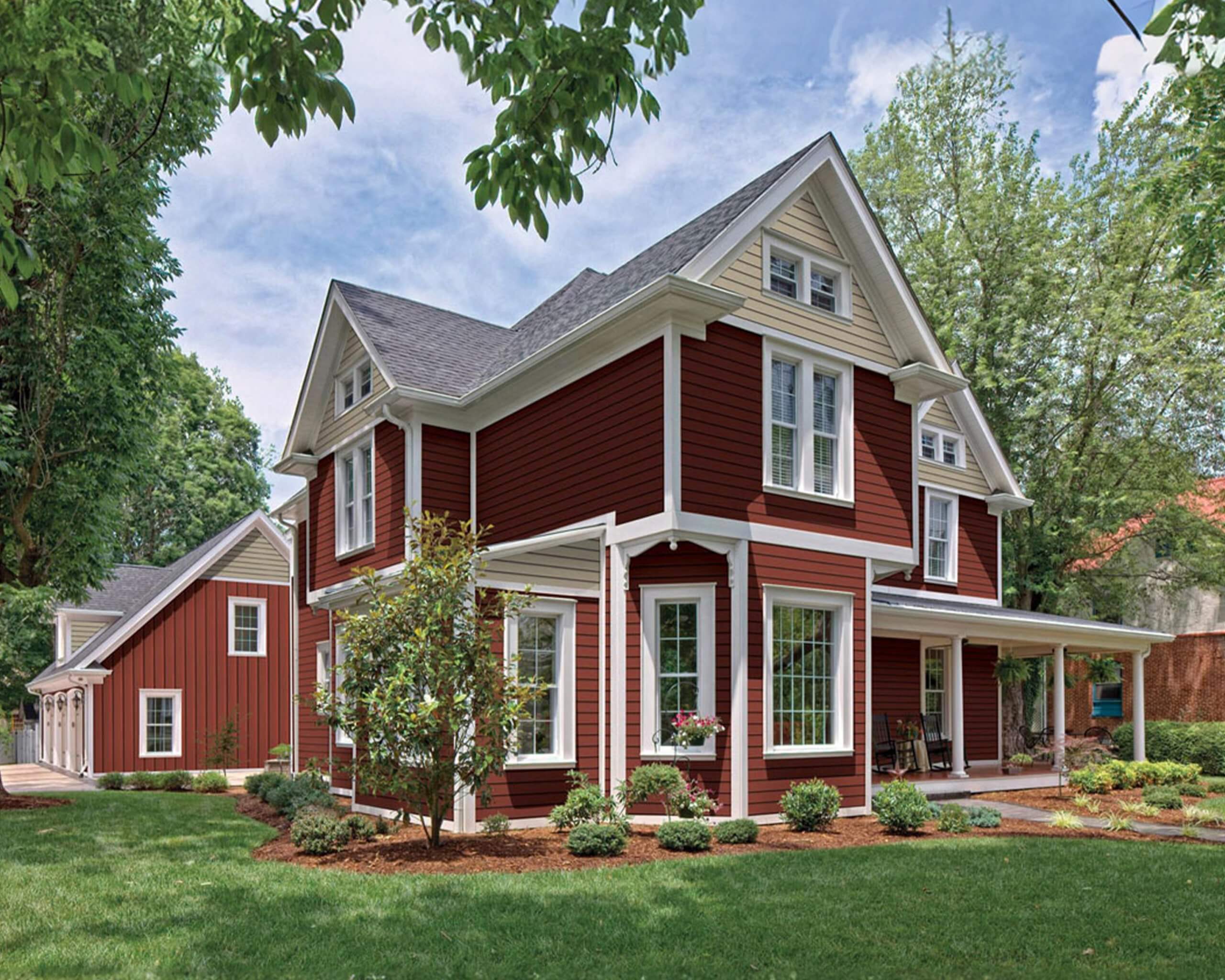
Photo courtesy of Royal Building Solutions
“Royal, among other manufacturers, produces a wood-looking siding in either aluminum or steel, so you have the maintenance-free aspect of it, and the longevity and the look of wood, which is everyone’s favourite thing to have on their house.”
He adds, “I don’t have to touch it, I don’t have to paint it, I don’t have to maintain it, (except) maybe a cleaning every once in a while, and it always looks as if it was brand new.”
Of course, colour and style preferences shift by region. “Dark colours are still very popular,” says Eric Peloquin, Manager of Retail Sales at Gentek Building Products. “It almost seems like you can’t get enough black in the house. But then, in some regions, there’s been a return to white or, instead, going with a beige or light grey.”

Photo courtesy of Gentek Building Products
Dark colours are only good if they don’t fade, and Diana Sousa, Marketing Director at Kaycan says “With bold colours being one of the top trends, it is imperative for contractors and builders to know about the technology behind keeping those colours true throughout the years. As dark pigments absorb heat at a higher level than lighter shades, we developed our Helios and Colorfast technologies to protect the siding from distorting and fading, thanks to these unique technologies, we can offer a 25yr fade resistance warranty.”
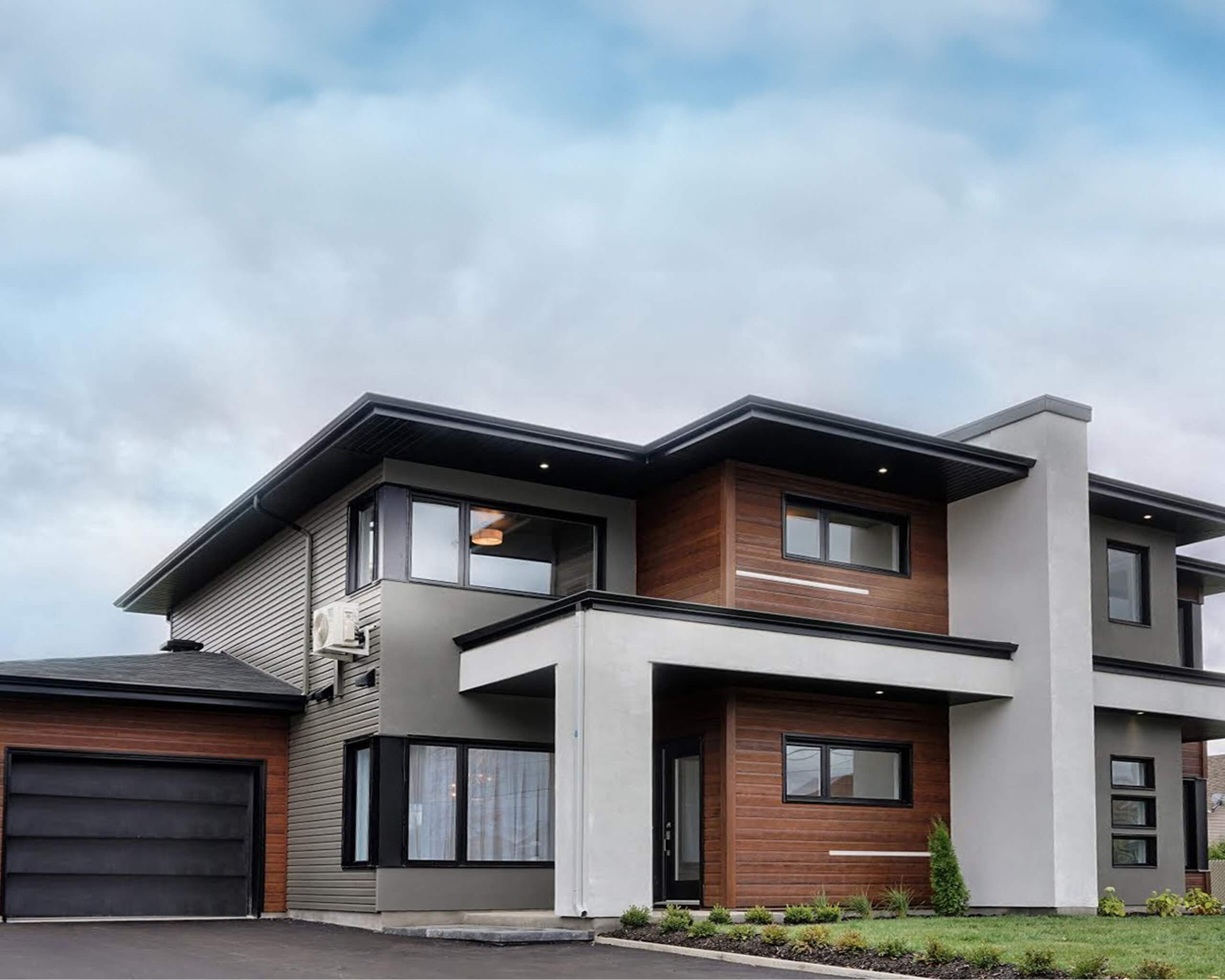
Photo courtesy of Kaycan
Mix-and-match design
The trend of a mixed material design aesthetic that started a few years ago has continued to grow. It’s all to give the home a singularly unique look.
“We call it mix-and-match design. Whereas before designers, homeowners, and builders would go with a similar look on the four walls of the house and the same model of siding, we now see sections of the wall may have more typical vinyl siding, but at the bottom there’ll be (siding with) a stone or wood look,” Peloquin says. “You’ll have these different products, and different colours all blend, but people are moving away from a single look for their house.”
He adds, “Because now there are so many choices for exterior cladding, you can have a curb appeal that’s different than your neighbour.”
On that note, as appearances go, the “faux wood” look is one of the trends Peloquin says has perhaps exploded the most over the past three or so years. “Anything that looks like wood but doesn’t have the maintenance required, and that could be a PVC, steel, aluminum…”
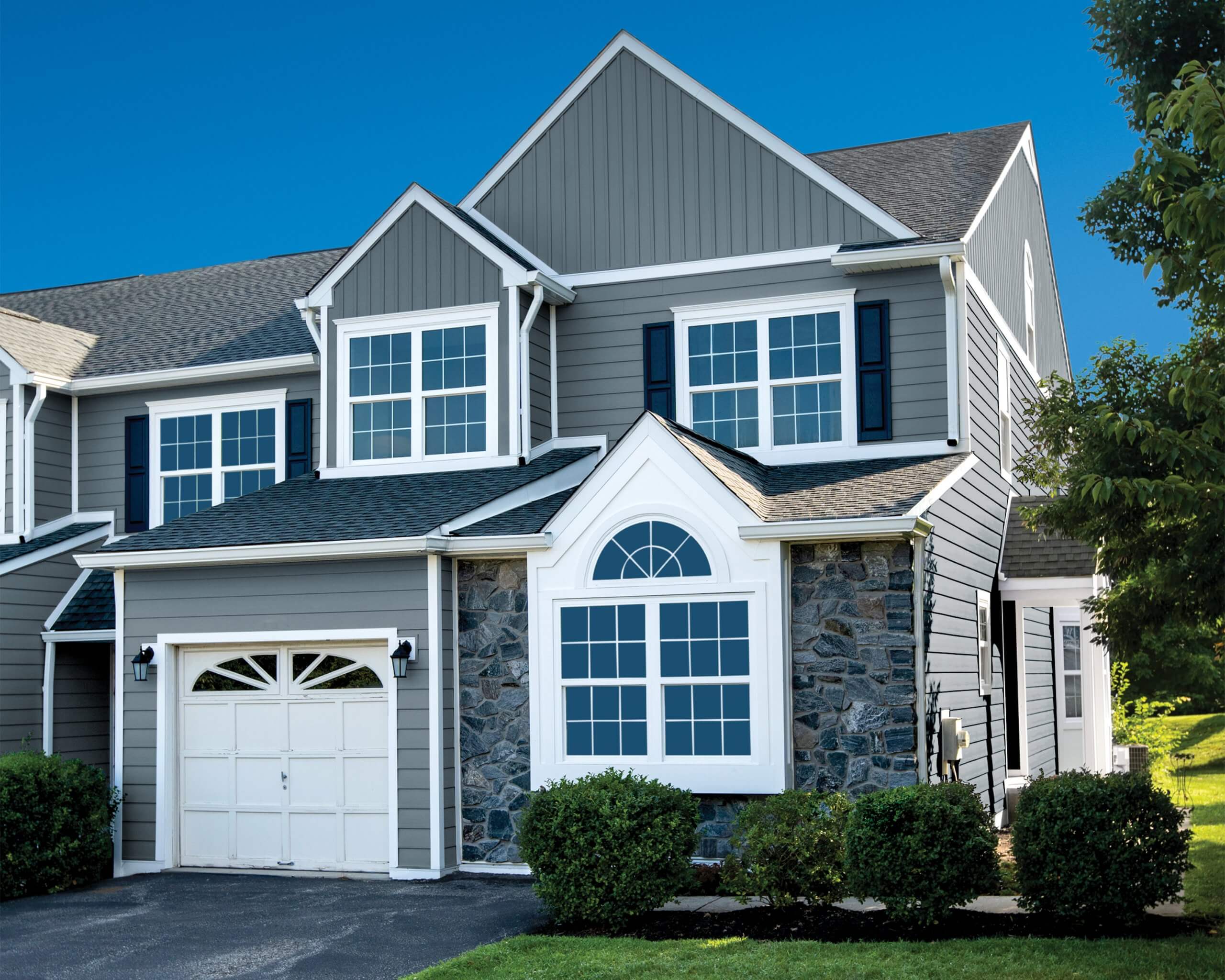
Photo courtesy of Gentek Building Products
Sousa says mixing textures is one of three major trends her company is seeing, including sustainability and modern contemporary design.
“Houses are now seeing three to four different types of materials on the exterior. This is a great way to add instant curb appeal and draw the eye towards architectural focal points,” she says. “We love the juxtaposition of sleek aluminum paired with the warmth of engineered wood siding or mixing horizontal vinyl with vinyl board-and-batten in the same colour to create visual interest.”

Photo courtesy of Kaycan
An urban farmhouse design essential
Scatozza points out that a classic American siding profile, board-and-batten remains popular. Sometimes dubbed ‘barn siding’, the profile is so named because it’s created using wide boards — traditionally wood but now in many materials — spaced with narrower strips, called battens.
“Board-and-batten has taken off in the last few years,” he says. “It’s drawn quite a bit of interest from homeowners, so contractors are looking for those profiles.”
He says, interestingly, he’s been seeing an increase in requests for board-and-batten profiles of his company’s Haven Insulated Siding in white and marine blue. Made using graphite-enhanced EPS (expanded polystyrene), the siding combines the look of cedar with unique heat-reflecting technology — and 16 colours.
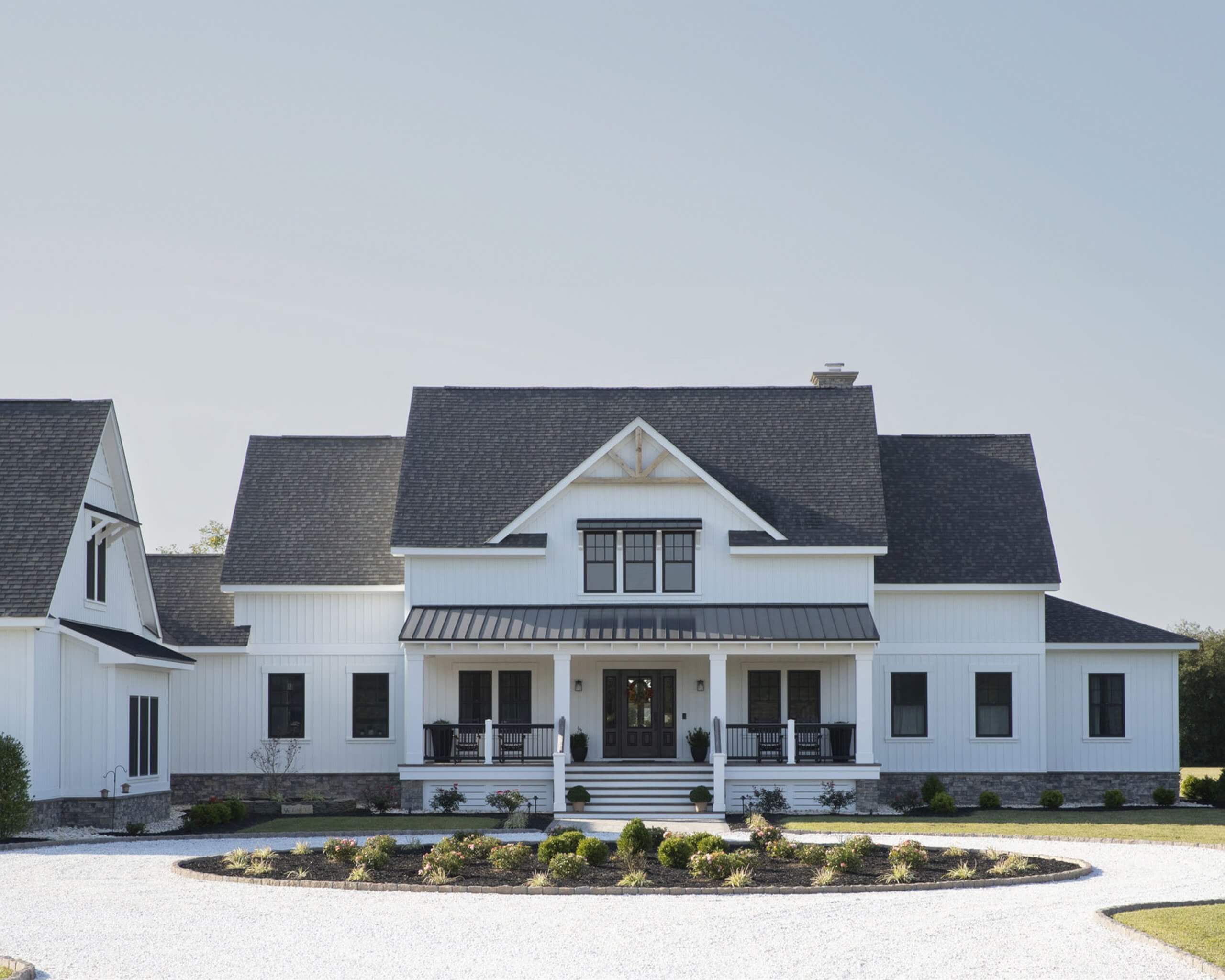
Photo courtesy of Royal Building Solutions
Peloquin says Gentek sees the growing trend of board-and-batten and urban farmhouse designs in some regions, while in others, the industrial design aesthetic has become more popular. “Both of these designs are popular at the same time, depending on where you’re located,” he says, reiterating the breadth of available products. “They require totally different kinds of products, but they are all available.”
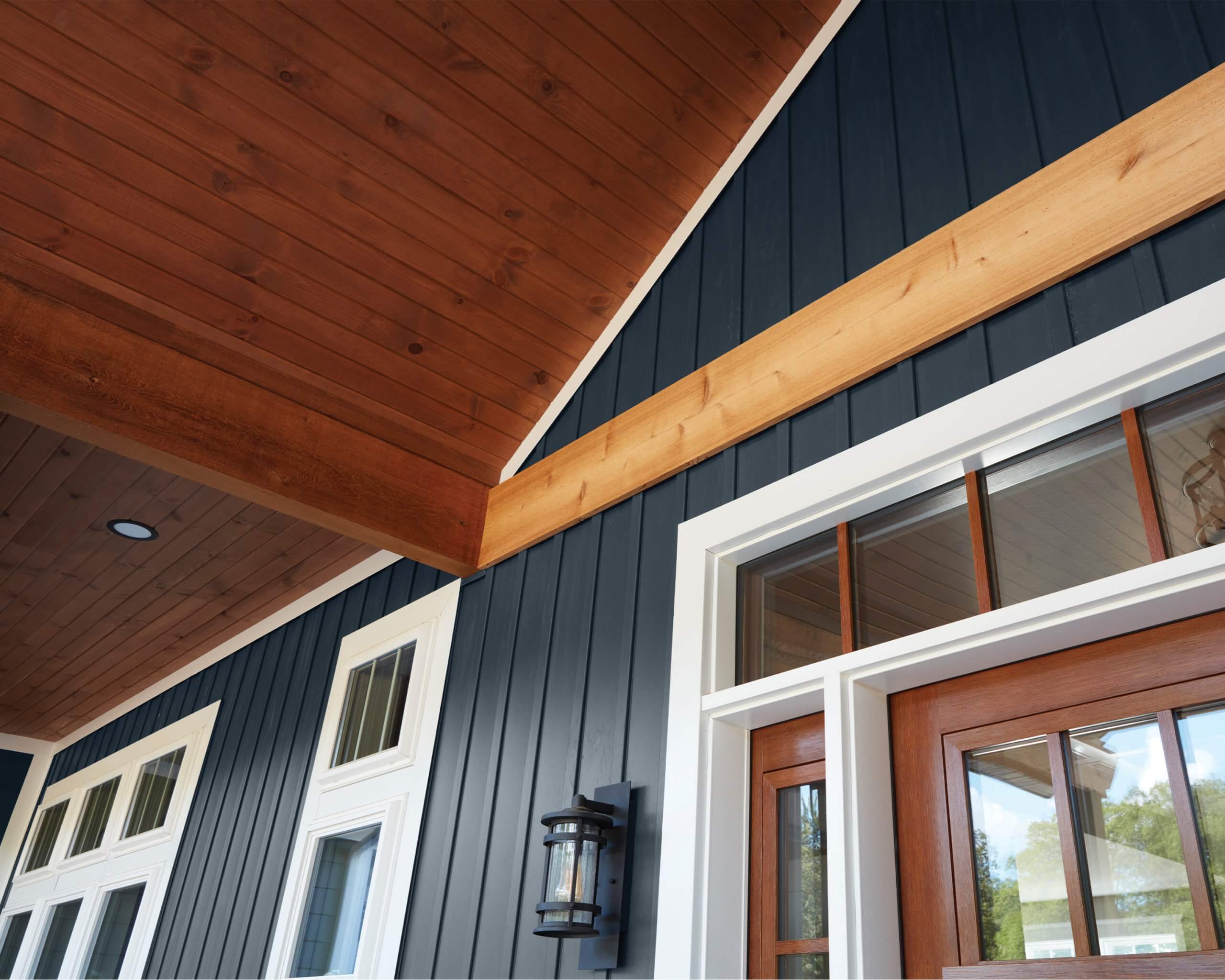
Photo courtesy of Gentek Building Products
Clad in steel
In terms of metal sidings, steel appears to be on the rise. “We’re seeing a big lean towards steel right now,” says Greg Gardenits, National Director of Sales & Marketing at Westman Steel Industries.
He says this has come in part based on disappointment with other materials and because “steel holds the test of time.”
“If you travel throughout Europe and the old world countries, and to use roofing as an example, you see a lot of steel roofs that are 500 years old, 600 years old, or 800 years old, and they’re still standing and doing the job they need to do.”
He suggests that this translates into longevity for steel siding products. While a decade ago, steel siding might not have been common in the residential space. “There weren’t a lot of colours, and there was the feel in the marketplace that our ‘better halves’ wanted to see something nice on our home and didn’t want it to look like a barn.”
That’s changed. Today, Westman boasts 43 different colours of steel siding and various profiles meant to appease the vagaries of a wide range of designers and homeowners.
“We’ve got paint finishes that are textured paints or paint finishes that look like wood grain,” Gardenits says. “We’ve even got finishes that look like rusted steel, believe it or not.” All to meet the designs and demands in the marketplace (of course, rusty-looking or not, it’s good as new and carries a full warranty, he notes).
Gardentis says the benefits of steel for homeowners are its strength, performance, and sustainability. For contractors, it’s the ease of installation, requiring no specialized tools, and an opportunity to stand out in a profitable market. Gardentis suggests that while steel siding can have costs similar to Hardie Board, it has lightness and ease of installation that allow it to go up as fast as vinyl. It’s not for new homeowners.
“You’re seeing more and more sustainable products now going into each zone. It’s no secret that we can’t keep ripping off asphalt shingles and vinyl siding and putting it in landfills; steel is 100 percent recyclable.”
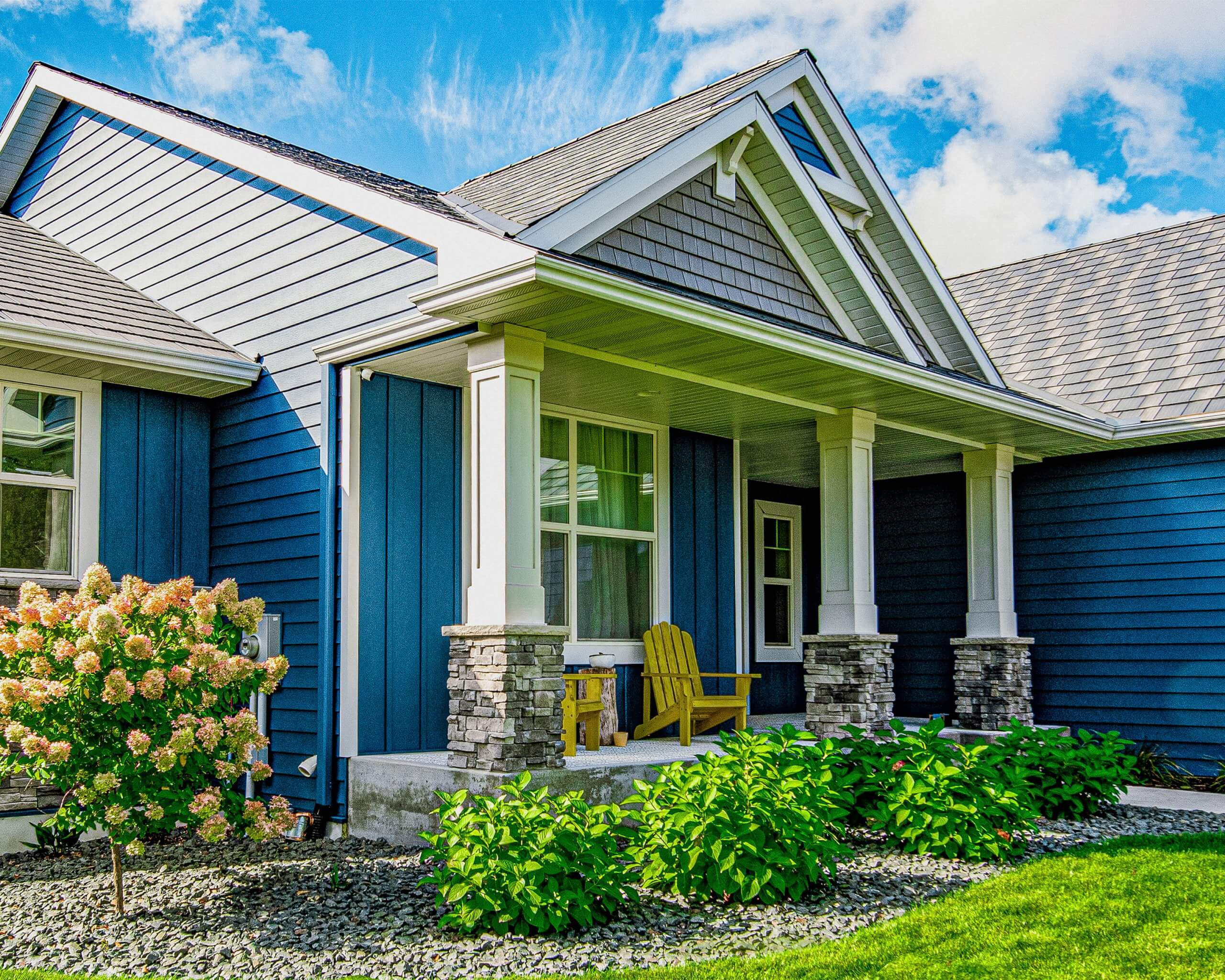
Photo courtesy of Westman Steel Industries
Sustainability demands
As with perhaps every area of renovation, homeowners are seeking more environmentally friendly and sustainable siding solutions.
“Homeowners are increasingly interested in eco-responsible materials, seeking options that align with their values. They even go as far as to research the companies and manufacturers sustainable efforts prior to considering their products,” Sousa says. “Contractors need to be able to offer sustainable solutions combined with contemporary colours and design to stay on trend.”
To that end, she says, contractors need to be aware of their manufacturers’ sustainability efforts.
“At Kaycan Saint-Gobain, we implemented our R3v program, which stands for Reclaim, Regrind and Repurpose vinyl. We encourage our customers to return used vinyl siding to our facilities for us to regrind and repurpose them into starter strips. Our manufacturing facilities are also mandated to be highly efficient in regard to water conservation and waste management.”
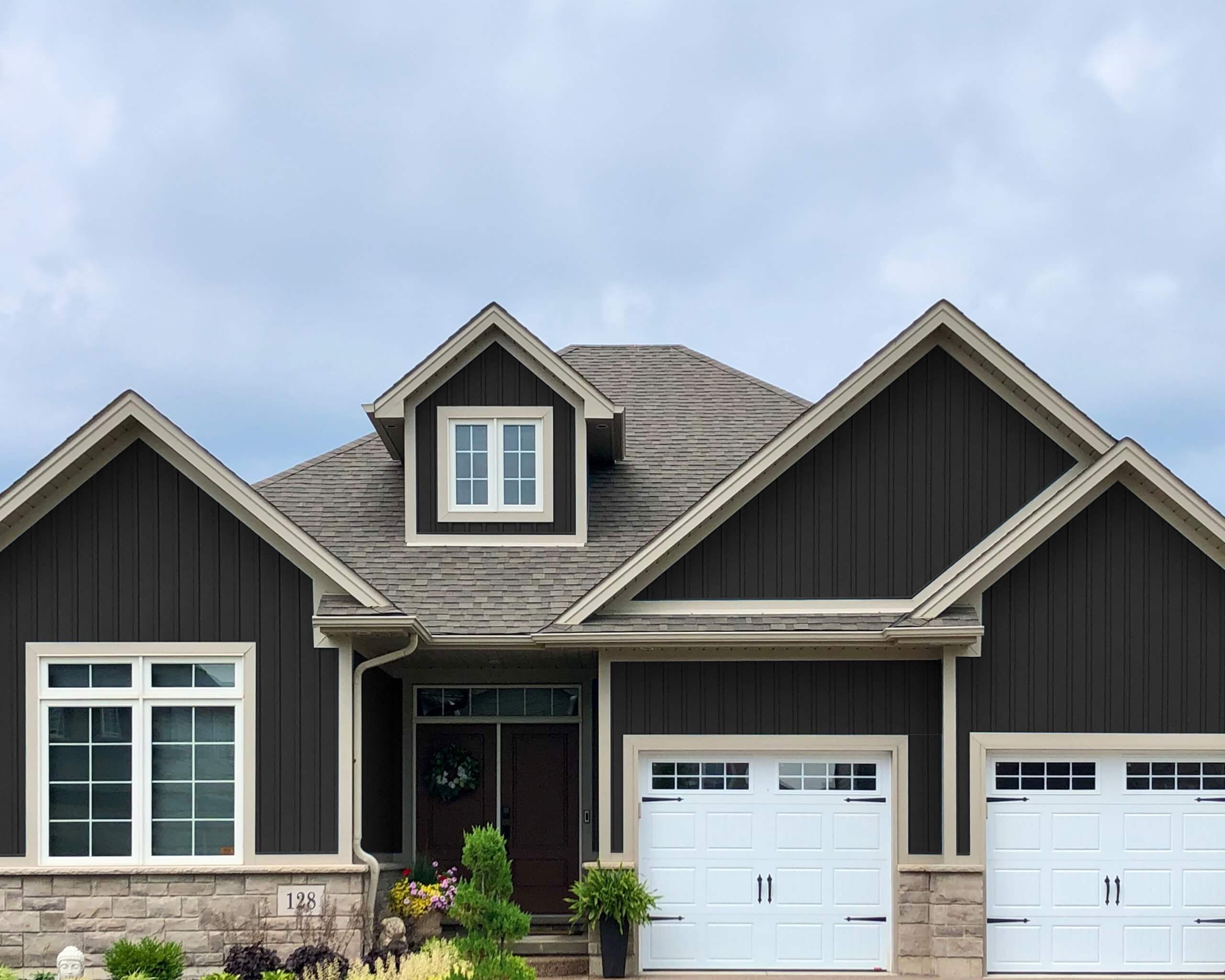
Photo courtesy of Kaycan
The sound of silence
While reducing heat transfer for energy efficiency is top of mind, it’s not the only way the right insulation can contribute to homeowners’ comfort. Scatozza notes that while his company’s Royal Haven insulated siding provides R-value to contribute to the home’s energy efficiency, its sound attenuation capabilities also provide value.
He speaks to a first-hand example of a home he visited after an installer replaced an old Insulbrick-style siding popular in the ’60s and ’70s with Royal Haven insulated vinyl. “I was in the area and looking at the house, and the homeowners came out and asked me what I thought… And they said, ‘Yeah, we noticed the sound we used to hear from outside has diminished substantially, which is an unexpected benefit.’
“That was nice to hear, and that’s why I bring sound attenuation up.”
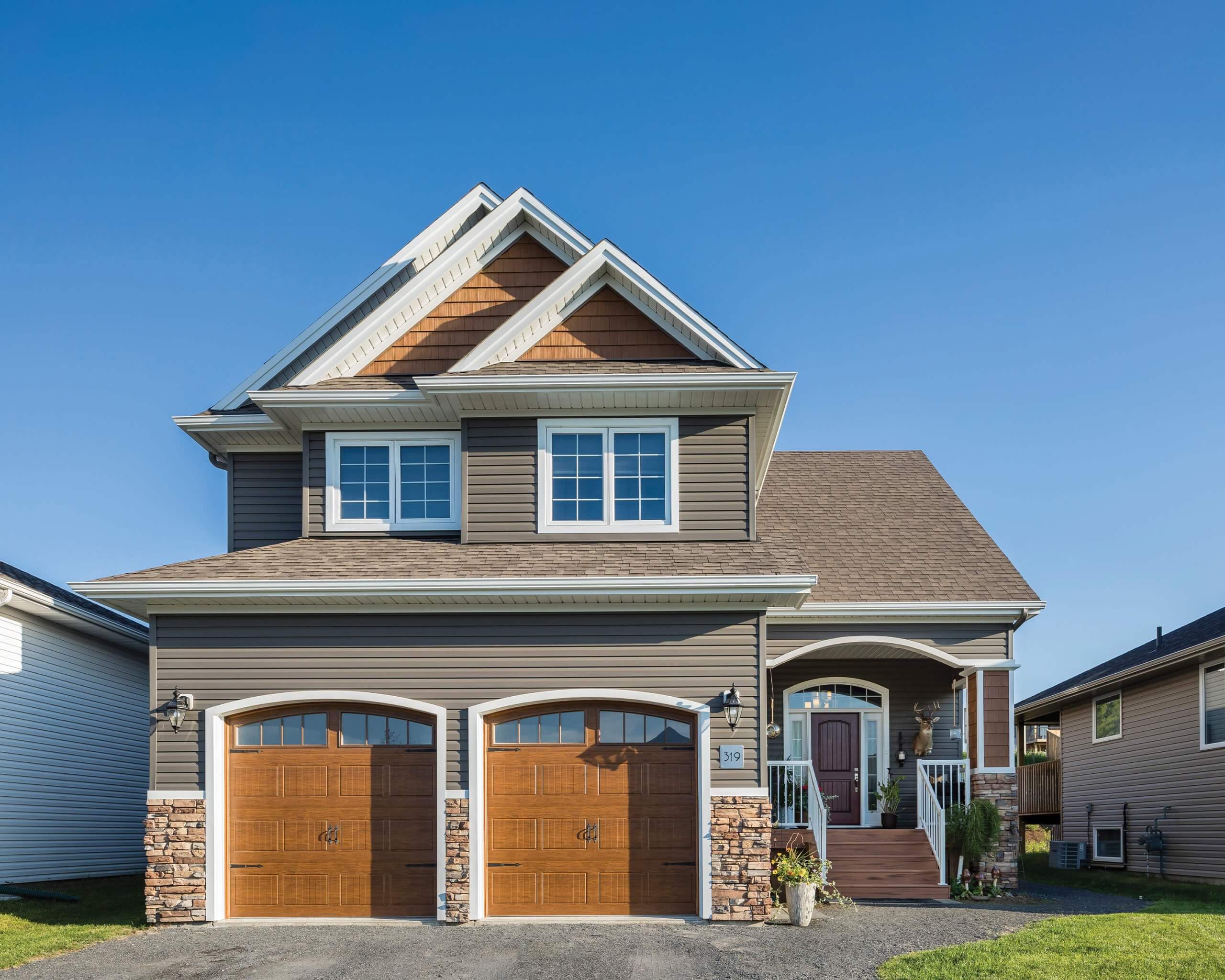
Photo courtesy of Royal Building Solutions
Composite siding market grows
One siding product category Peloquin says has “really taken off” over the last two or three years is its Align Composite Cladding.
“Instead of regular PVC, this composite is made from a glass-reinforced polymer with insulation in the back that’s graphite-infused polystyrene, so it’s a different kind of product that touches on all the benefits: easy to install, light, no maintenance, and a nice long warranty. Everything that people are looking for.”
Further to homeowners’ desire for low-maintenance, wood-looking products, Scatozza says interest in composite PVC siding, like his company’s Celect Cellular Composite Siding, has “exploded in recent years.”
He says it has all the look of wood, but with the water resistance and low maintenance homeowners seek. Showing the interwoven popularity of composite technology, urban farmhouse designs, and a growing trend towards wider profiles, Royal last year added an 11” board-and-batten profile to their original 8” Celect offering.
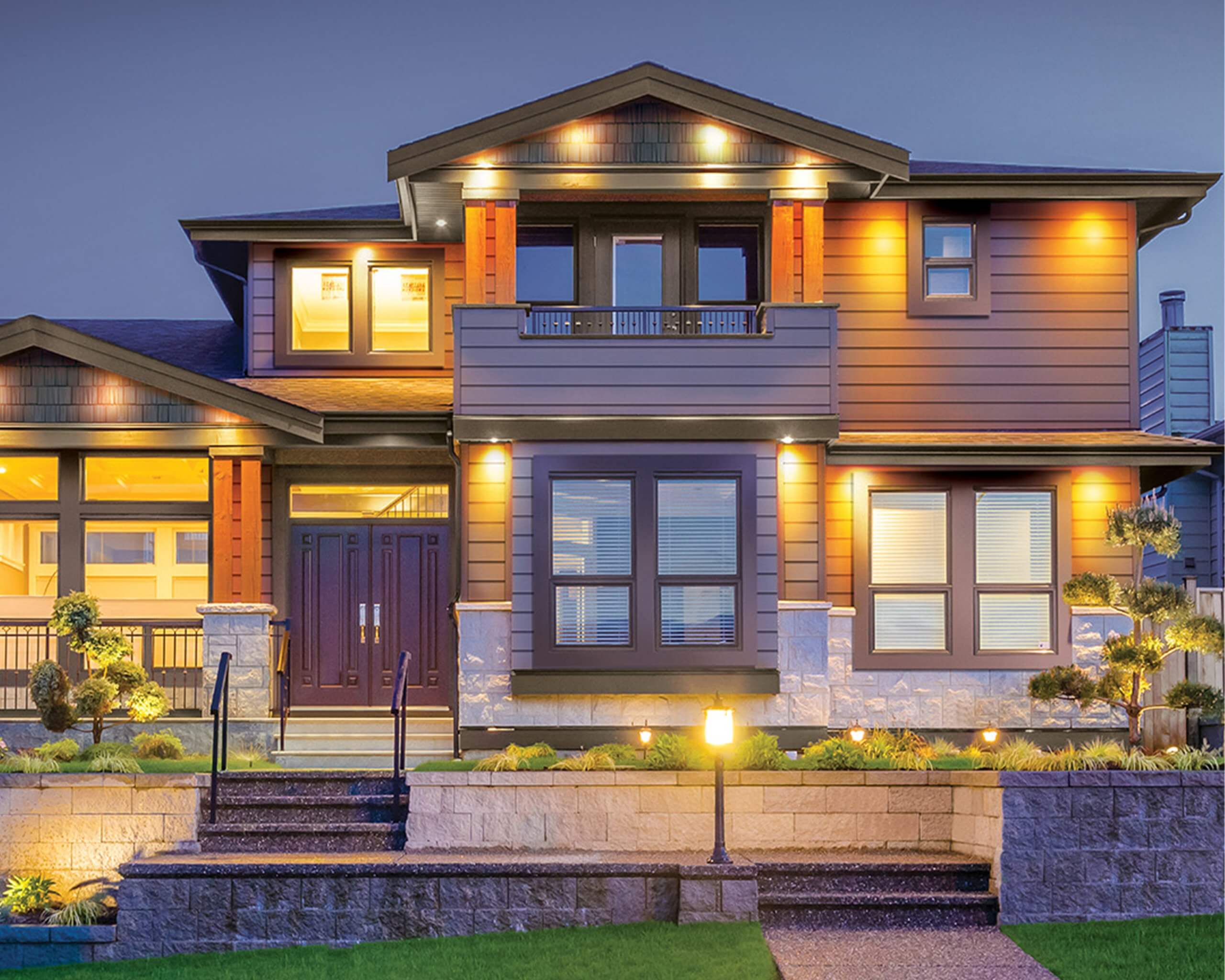
Photo courtesy of Royal Building Solutions
The need for installation ease
As the industry continues to be hit with challenges around finding skilled labour, ease of installation has become more and more important for both contractors and homeowners.
For homeowners, faster installation can mean savings on labour costs, while for contractors, it could be the difference between having available installers or not. With that in mind, every siding vendor emphasizes the value of their products’ ease.
“Labour is still a challenge out there, and there doesn’t seem to be as many people available to install siding,” Peloquin notes. “If you have a product that’s low-maintenance but also easy to install, we see a lot of demand for that.”—
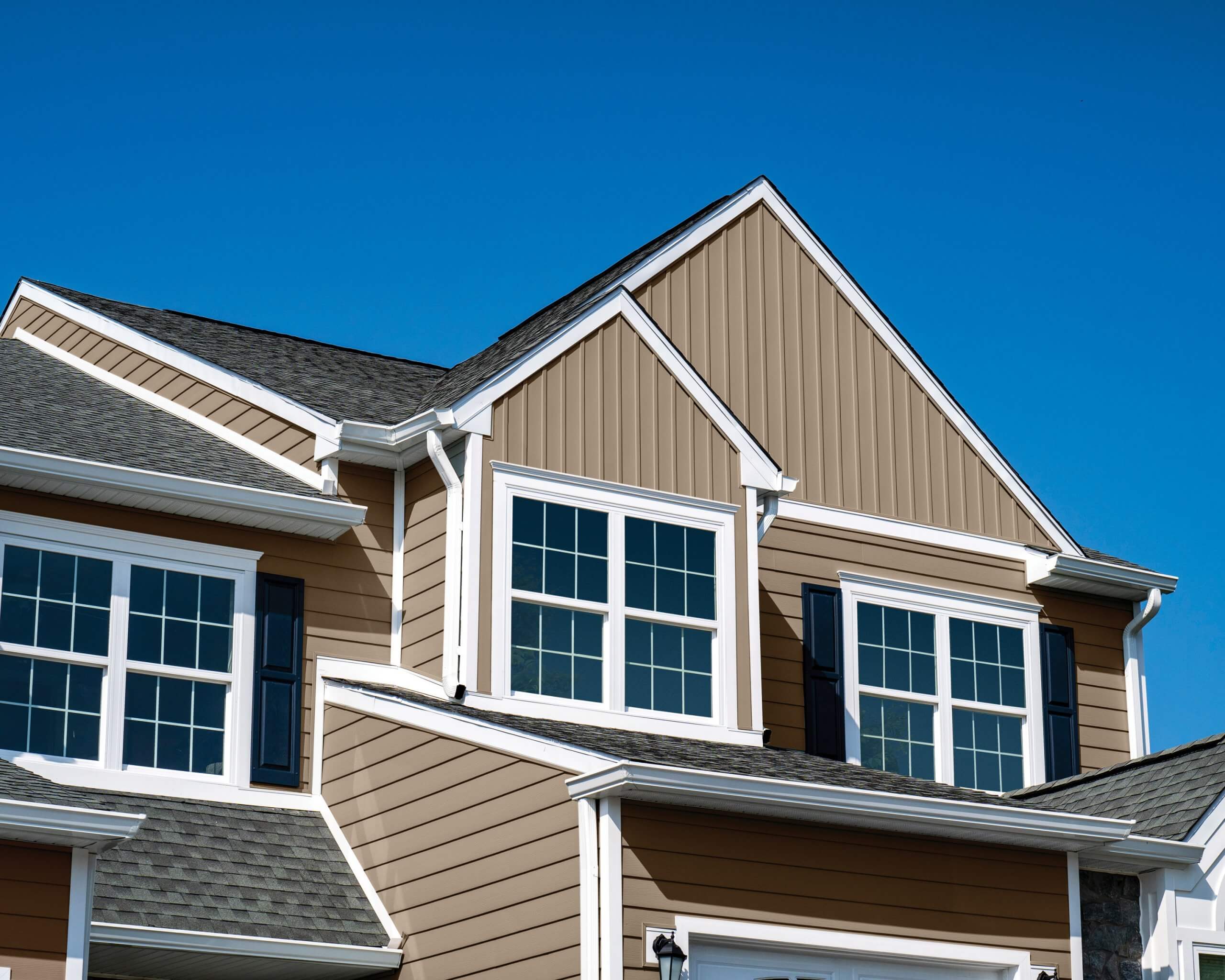
Photo courtesy of Gentek Building Products
